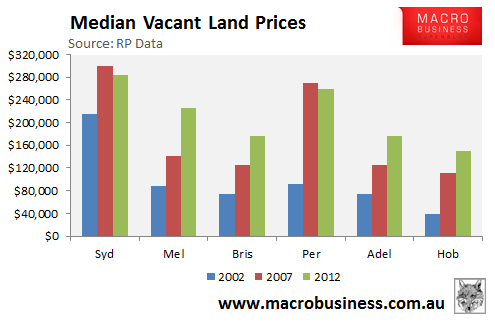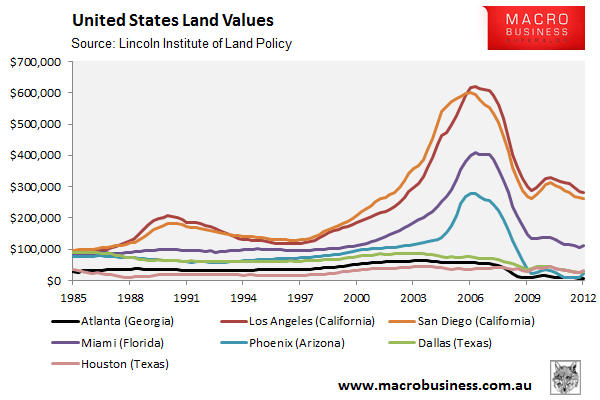
The Wall Street Journal (WSJ) has an interesting article today on the supposed “boom” in US residential land prices, which are beginning to place upward pressure on new home prices:
Land values across the U.S. rose on average 13% in 2012, the first annual gain since 2005… The increase was fueled primarily by growing demand among builders for finished lots, or ready-to-build home sites with roads, sewage lines, electrical-power hookups and other infrastructure in place…
For consumers, costlier land means more-expensive houses. Land cost constitutes 21.7% of the final sale price of a new home, according to the National Association of Home Builders. As land prices rise, builders tend to pass 100% of those costs on to consumers.
Buck Horne, a housing analyst with Raymond James & Associates, predicts that new-home prices will rise 10% to 15% in 2013, chiefly because of rising demand and because of the scarcity of land. “Buyers who can’t afford to pay up now are going to have to wait. Maybe they’ll have to rent for awhile,” Mr. Horne said. “They may miss out on the first stage of price appreciation”…
To be sure, land prices nationally are still far from the peak levels reached in 2005 and 2006. They also are notoriously volatile. In 2009, for example, as the first-time home buyer tax credit stimulated demand for lower-priced new homes, land prices rose, but leveled off and fell slightly when the tax credit expired and demand cooled…
A few things to note about the WSJ story. First, the claim that land in the US costs only around 22% of the final price of a new home is staggering when compared to Australia, where land values on new houses typically cost between 50% and 70% of the price of a new home (see next chart). No wonder new housing in the US is, overall, so darn cheap!

Second, not all land markets in the US are equal. Those with more liberal land supply and relaxed planning tend to have far lower land prices than those markets where supply is more restricted, either through regulation or physical barriers. The below chart draws on a sample of land prices from the Lincoln Institute. As you can see, the cities with liberal land supply and relaxed planning (represented below by Atlanta, Dallas and Houston) experienced far lower average residential land prices, as well as greater land price stability, than markets where land supply was restricted, represented in this case by Miami, Arizona, and some cities in California.

Those seeking to “fix” the housing market should, in the first instance, look at policies affecting land values.

